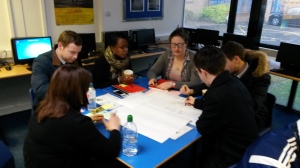The Westfield recipe for great learning was reviewed this week, based on the previous 6 sessions this term.

Breaking with usual practice we worked in groups to gather ideas, strategies and best practice for how each ingredient can be developed and highlighted in our lessons.
Group 1: Selling and supporting the vision
How do we motivate and generate our high expectations and a can-do attitude?
Our systems need to be used consistently here, as well as basic human skills of interaction and mutual respect:
-Clear, consistent routines – timings, seating plans, objectives & outcomes,
-Values – resepct, accountability, expectations of behaviour, resilience & positive reinforcement
-Strategies – scaffolding, questioning & feedback
Group 2: True starting points
How do we know the students, and show this in our planning and delivery?
-Context sheets, living breathing ones are central, based on Go4 Schools, as well as what we do that works – a personalised document informed by colleagues and a dialogue with the students.
-SEN booklet, Reading & Spelling ages, CATs, Pastoral information, Risk assessments, G4S all inform
-Dialogue – with the students, tutors, previous teachers & home
-Our marking & previous assessments
-Pupil feedback – talk with the students & get to know them!
Group 3: What are we learning today?
How clearly are the lesson destinations clarified with classes? Are we certain ourselves?
-Being the Einstein of our subject works here, knowing the scheme, syllabus and what you want students to learn today. All this encapsulated in clear objectives, outcomes and success criteria.
-Hook them in with a clear, relevant starting activity. How does it relate to what they know already?
-Consolidate learning throughout the lesson, in-line with the objectives & outcomes
-Scaffold learning to build understanding & support progress
Group 4: How do we know?
What strategies do we use to highlight and test proof of learning amongst the students?
-AfL, but variety – self, peer and teacher assessment. Give time for a response following the Blue stickers
-Questioning – plan this, but respond to the flow of the lesson and the learning that you hear& guage from this assessment. Thumbs & traffic lights will help here.
Group 5: Challenge and motivation, pitch and engagement are vital in the lesson – so how do we do this, and how do know both are on the money?
A trip back to the context sheet would be good here, knowing what works with the class you are teaching.
-Different activities, making it competitive and developing independent work
-VAK, and a balance of activities in each, so all learning styles are developed
-Group work, wirh specific responsibilities so all are accountable
-Scaffolding where necessary
Group 6: How do learners know how to close the(ir) learning gap?
How do we enable learners to untangle the web? What feedback strategies can be used with our classes?
-Exemplar work, past papers & model answers
-Level & grade descriptors
-Planning in our lessons, with specific progress checks built in to lessons
-Success criteria are easier for peer assessment
-DIRT
-Marking, with clear feedback and response time
Group 7: How can all these ingredients be brought together into a collective whole, comprising a well-planned and successful lesson?
Packed with creative, artistic colleagues, there were high hopes with this group. Would they pastiche a smorgasbord of ingredients to make a satisfying dinner? A business approach of flow diagrams leading to a final product? A Christmas tree football formation a la Brazil 1970?
The task was clear – how can these ingredients come together to form successful learning for our students?
A man in green Y fronts was sketched. His super powers encompassed the 6 ingredients of successful lessons.
It was a Tuesday morning.

